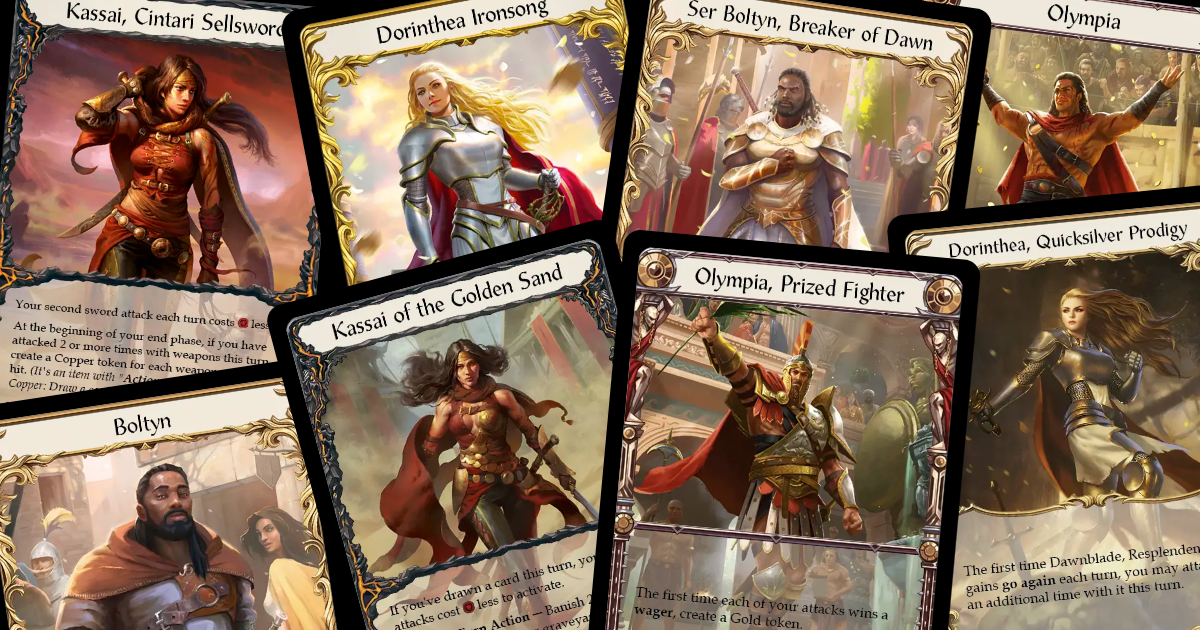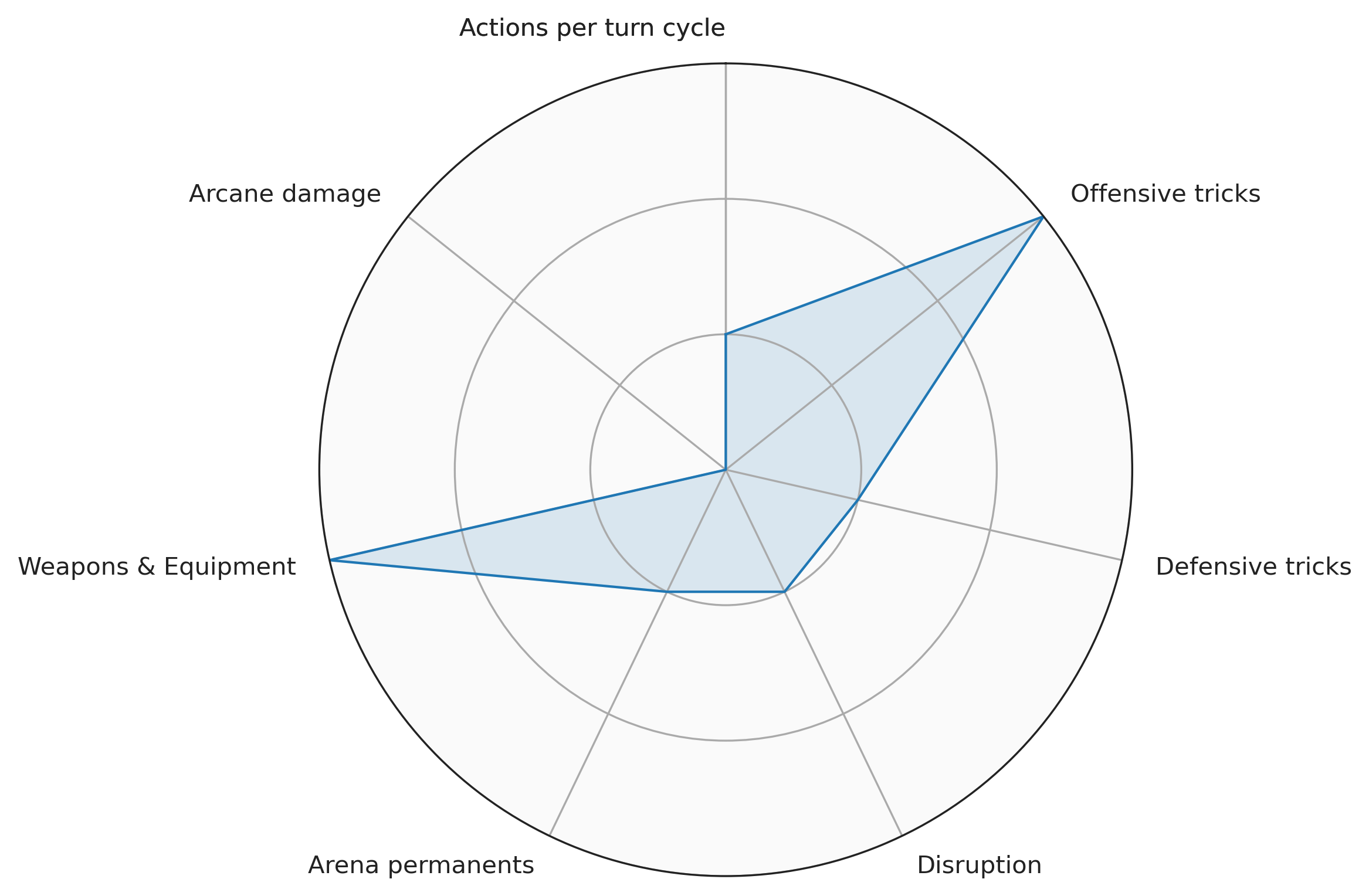ClassID - Warrior
Them: Swing weapon for 2.
You: I’ll block 3.
Them: Okay, I’ll give it +3 and go again. And then swing weapon again.
If this play pattern sounds familiar, you probably faced a Warrior. Perhaps not the fancy talented kind, but the classical Warrior design. And that is exactly what this second installment of the ClassID series is all about. This week we are talking about the reliable Warrior class, first introduced as part of the original cast in Welcome to Rathe. Just like the Ninja class, which we discussed in the first article, the Warrior class is a martial class, but as we will see below, they play very differently.
En Garde
If I had to concisely convey the identity of the Warrior class, I would do so by playfully declaring “en garde” and letting your associations take over from there. This fencing term perfectly encapsulates what the Warrior class is all about: you are telling your opponent “be on your guard, or I will pull a fancy trick on you”. What this comes down to in terms of gameplay, is a weapon-focused class that performs most of its heavy lifting in the (attack) reaction step. More than any other class (except perhaps some Mechanologist playstyles), Warriors rely on their weapon, and thus you are ideally swinging your weapon(s) every turn. This is a powerful playstyle because weapons are always in play and thus you only need a card to pitch, right? Well, … no. Aside from Decimator Great Axe (which defines an archetype within the Warrior class on its own), Warriors have no weapon with a base strength of more than 3, which is less than the 4 damage that you want to present off of a single card and action point. Instead, you will be tacking go again onto your weapon swings.
Just looking at some of the Warrior weapons, like the Hatchets of Body and Mind, this is immediately evident. To maximise the hatchets’ value, you have to attack with one after the other. However, they lack inherent go again and thus you have to find a way to give it go again. Luckily, there is no shortage of Warrior attack reactions that allow you to do just that, e.g. Blade Runner. With hatchets, a two-card hand with a blue card to pitch and a red Blade Runner becomes a two-card 8-damage play, exactly the minimum rate we are aiming for. Throw in some incremental value like Valiant Dynamo and we are off to the races!
Actually, forget about racing. Rather than racing your opponent’s health total down, many Warrior decks are based on “outvaluing” their opponent. They play a traditional game of both attacking and defending each turn cycle, whilst accruing value over time. A prime example is blocking with Valiant Dynamo every turn, but this design theme is also clearly present in Dawnblade and Kassai’s hero power(s) and specialization(s). If you overcome Dawnblade’s once per turn limitation and hit twice with it in the same turn, it gains a +1 damage counter, making it a better value proposition and harder to block. Similarly, the more turns Kassai of the Golden Sand has, the more free attacks she will have. This really adds up in a longer game, and that is not even accounting for her second ability. If you are able to collect Gold, which sticks around in the arena and is a form of value on its own, Raise an Army allows you to fully display how outclassed your opponent is value-wise.
This talk of Dawnblade and Kassai’s Gold generation brings me to my final note on Warrior design: hitting with your weapon. Re-reading Dawnblade and the second ability on Kassai of the Golden Sand, it is clear that Warriors want their weapons to hit. However, if you were just presenting low-value weapon attacks, this would not be effective. That is why I mentioned in the beginning of this section that Warriors always have a trick up their sleeve. Many Warrior cards, like Blade Flurry or Rout, will add extra damage in the reaction step to push attacks to hit, and effects like reprise, which punishes opponents for blocking with cards from hand (as seen on Rout), will keep your opponent guessing what the best course of action is in each weapon attack’s defend step.
Warrior’s radar chart
With that general description out of the way, let’s see how Warrior scores on the radar chart:
Starting at the top and going clockwise, here is the motivation for each score.
- Though the Warrior card pool features quite a few cards that give go again, like Glint the Quicksilver and Spoils of War, their application is usually limited to weapon attacks. Since humans only have two hands, and thus at most two one-handed weapons, your amount of weapon strikes is generally limited to two (unless you are Dorinthea). Therefore, Warriors often chain two or three strikes, but this is about the extent of their amount of actions each turn cycle, though this can change in the late game if you have set up a combo turn with something like Raise an Army or Blood on Her Hands.
Warrior decks generally pack quite a few attack reactions, as their card pool features a lot of them. This is necessitated by the fact that they need their weapon attacks to hit as often as possible to generate additional value. Consequently, Warrior probably features the most attack reaction-heavy playstyle of all current classes. So if you want to keep your opponent guessing how much damage you are actually presenting, this might be the class for you!
The other side of the coin is less shiny though. At the time of writing, the Warrior class has only a single defence reaction: Steelblade Shunt. However, the caliber of this defence reaction earns the class a whole point in the defensive tricks category. Defending at a rate of 1 resource for 6 block is great (above rate), and if it is used on a weapon swing, you even get a point of retaliation on top of that! PLays well off of Tunic too.
- In the initial release, the Warrior class did not really have any disruption in their toolkit. Since then, however, the class has received a few disruptive cards at majestic rarity, most notably Commanding Performance in the last set, and Shatter and Emboldened Blade before that.
- Similarly to disruption, arena permanents were also lacking in the class’s original profile. Again, though, the Warrior class has since received a powerful aura in the form of Ironsong Pride, as well as V for Valor for Light Warriors. +1!
- As for the class’s other strength, it is definitely weapons and equipment. Naturally, with such a weapon-centric playstyle, come powerful weapons. As the original Warrior weapon and powerhouse, Dawnblade is of course iconic. Decimator Great Axe defines its own archetype, and for Warriors leaning on one-handed weapons, tantalising options beyond the hatchets can be found in Cintari Saber, Hot Streak, and Parry Blade. Pair these weapons with a great armour suite featuring the infinitely blocking Valiant Dynamo alongside full platemail like Courage of Bladehold and Braveforge Bracers, and even a shield (Bastion of Unity), Warrior generally has no issues covering breakpoint attacks without hampering their own offensive swingback too much.
- What’s arcane damage? — Olympia, probably
Who is the Warrior class for?
In conclusion, the Warrior class is for players who crave a bit of stability and enjoy eking out small advantages turn after turn. Your most powerful cards start in play already and the rest of your deck is only there to help unlock their full potential. With your fancy combat tricks in the attack reaction phase, you are sure to keep your opponent guessing and will be ready to punish them once they make a wrong assumption about that card in your arsenal.

